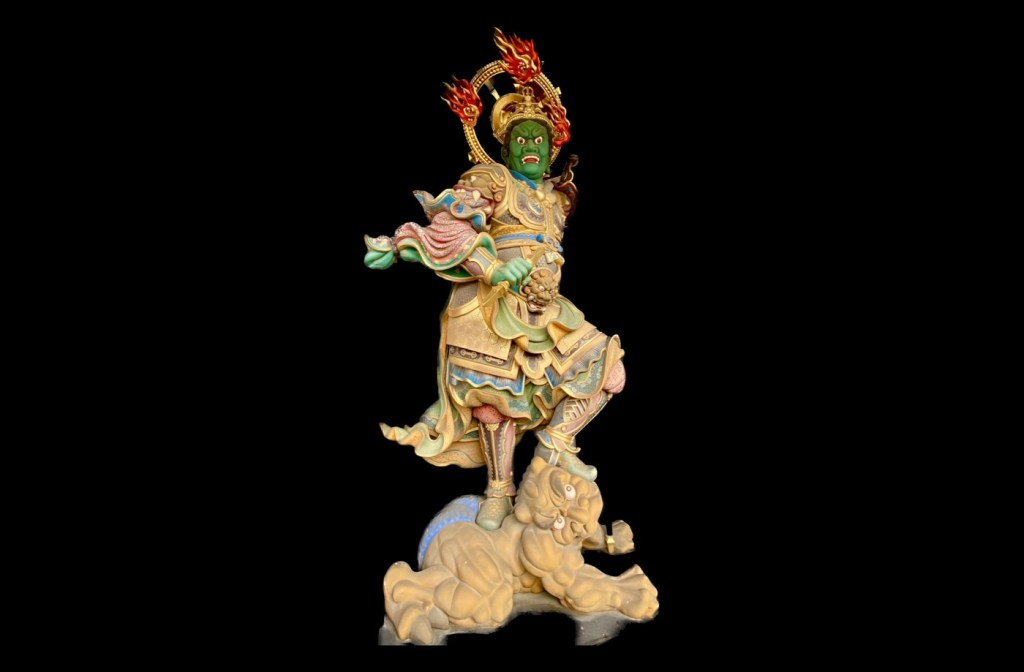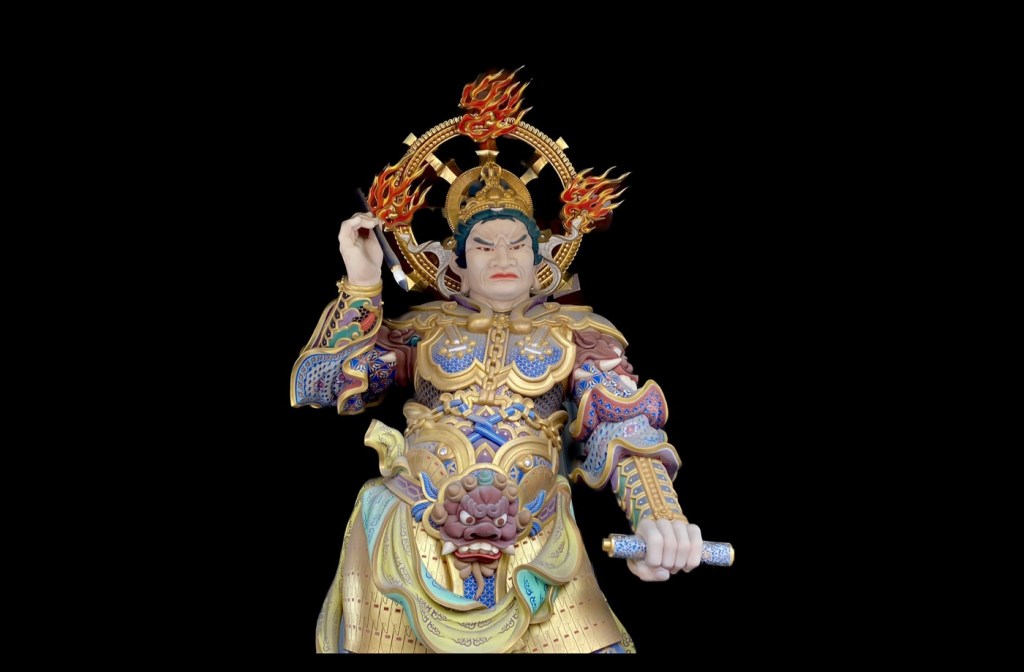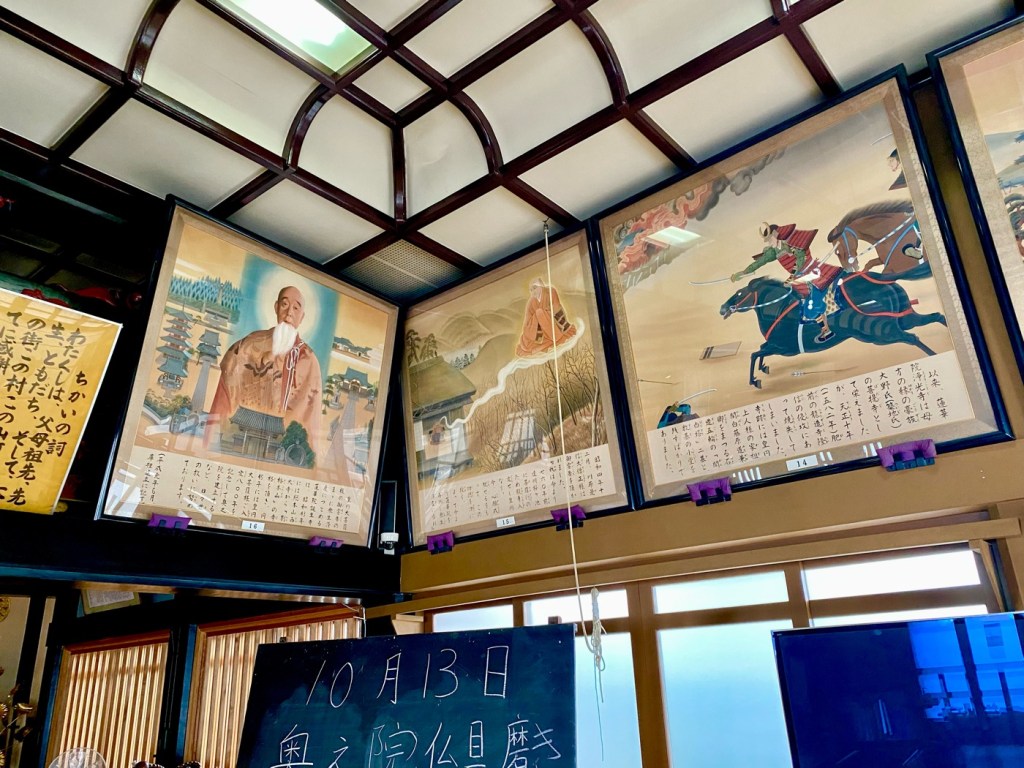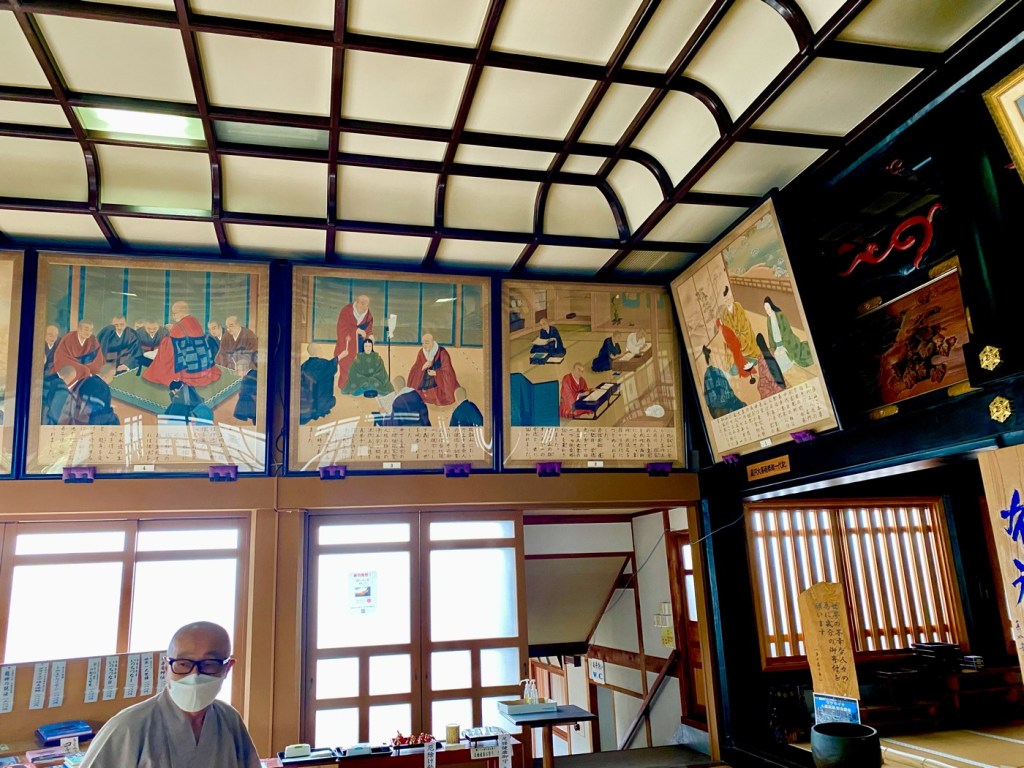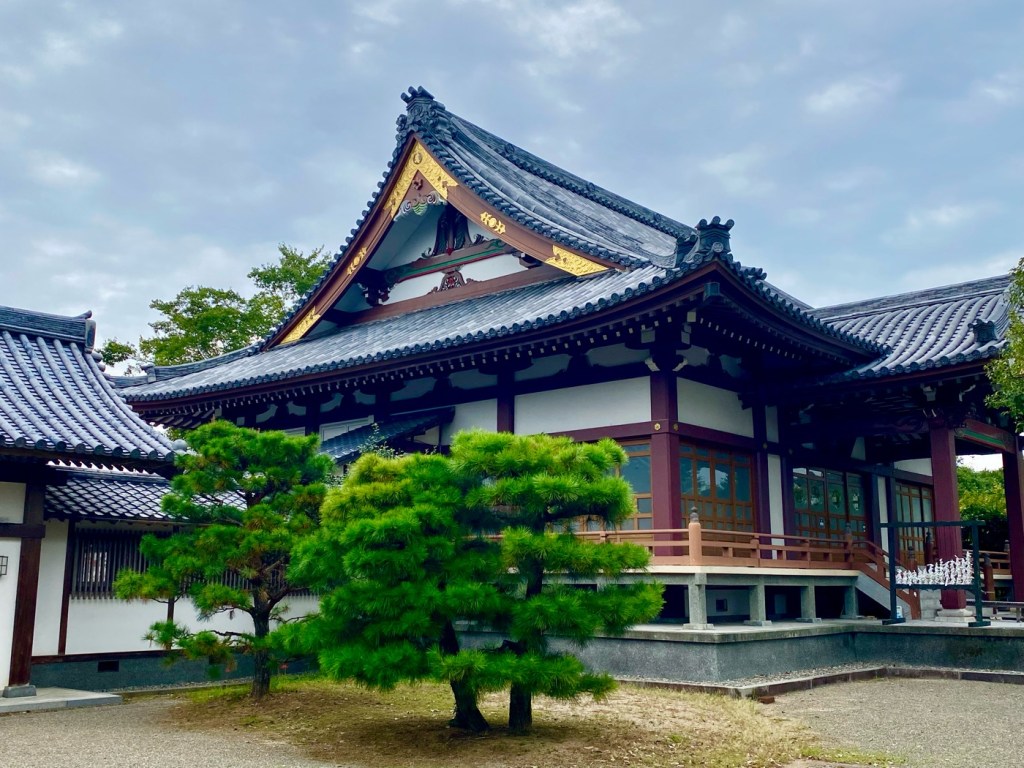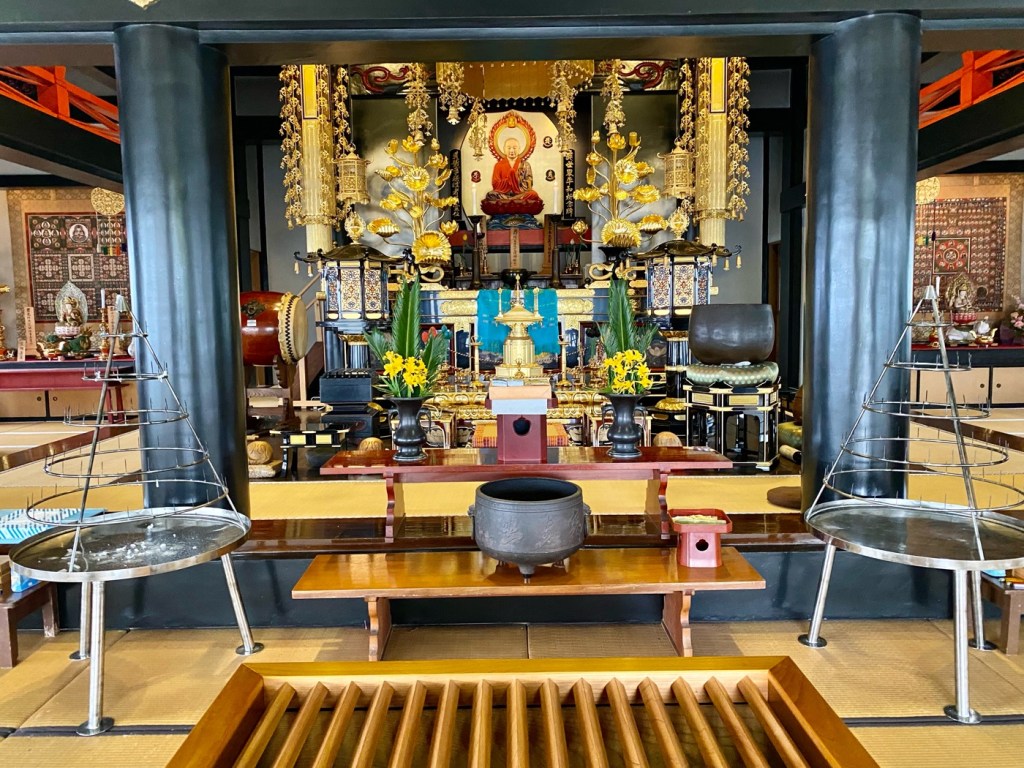Day 11 - Tamana and Arao, The Kyushu 108 Temple Pilgrimage, Japan
Day 11 - Tamana and Arao, The Kyushu 108 Temple Pilgrimage, Japan
Today we visited three temples located south of Kurume and north of Kumamoto.
The first temple of the day was a gorgeous 1000 year old temple with two pagodas and a big pond, an impressive bell tower and other beautiful buildings.
The priest spoke good English and he ushered us in, explaining the temple’s history and how the founder, a saintly monk named Köen Shonin, took a Buddhist vow to attain further spiritual powers in order to save mankind.
After his death, in the year 1169, he was transformed into a powerful dragon.
After we chanted, he applauded and took us into the inner shrine, to show us the beautiful hand painted mandalas and deities enshrined there.
He talked about the Buddhist paintings of heaven and hell, and how they differ from the concept of hell in Christianity.
While in Christianity hell is believed to be a separate realm that a person goes to in the afterlife, hell is seen in Buddhism as another dimension of life, a dimension of hungry ghosts who can never be fulfilled and live in anger, jealousy and greed, tortured by their own demons and egos.
Koen Shönin was born to a noble family on the very site of this temple, in the year 1073, during the Heian period.
His grandfather was the lord of Higo Province.
Koen took the novice ordination in his teens, and studied and practiced Buddhism on Mount Hie, which is situated to the north-east of Kyoto.
While still young, he was already recognized as a superior monk as well as an erudite Buddhist scholar.
He wrote Fuso Ryakki, an important Japanese historical text.
He also educated a great number of disciples, among them the now famous monk named Honen Shonin.
At the age of 74, he transmitted the foundations of Pure Land Buddhism to fifteen year old Honen, who went on to found the Pure Land School of Buddhism in Japan, and to become the teacher of the master Shinran Shonin.
The temple was destroyed in the year 1177 and restored in 1225 by the emperor.
However, the temple was unfortunately burnt to the ground during a war in 1582.
The late monk Daisojo Zeshin had a divine visitation from Bodhisattva Koen, asking him to restore the temple.
He did so and devoted the rest of his life to aiding people suffering from disease and misfortune.
We thanked the monk for all the attention and explanations that he had given us, and for the gifts of bottles of iced teas, and we left through the main gate.
The temple’s main gate is known as the Nio Gate.
On both sides of this two-storied gateway stand the statues of deva guardians called Nio.
The ferocity of the mighty guards is intended to frighten away all those who seek to destroy Buddhist teachings and wisdom.
Carved in 1980 by the master sculptors of the day, Horin Matsuhisa and his son Sorin, the cypress statues are the largest Nio guardians found in Kyushu.
There is also a five-storied pagoda on the temple’s grounds.
Among the 43 similar pagodas in Japan, this is the largest and the third tallest (51.5 meters or 169 ft.)
This pagoda is also the only one in Japan which allows visitors to enter and to participate in Buddhist training inside, like meditation, writing sutra, and attending courses.
From there, we walked to Arao where Temple #58 - Kongo-ji is located.
We could hear women chatting inside, so we knocked and entered.
The women were drinking tea and they invited us in.
Quickly they collected their purses and left.
After our chanting, a priest appeared and invited us for tea.
We sat on the low table on the tatami rice mats and talked.
He spoke about the Kyushu pilgrimage, saying that we are the first westerners he has ever seen come to the temple or do this pilgrimage.
He asked us why are we doing it.
He asked if there were Buddhist people in America or in Europe.
Then he spoke about the importance of peace, that we must stop fighting each other.
We are all one human family, and there is no need to fight and kill one another.
He said that there shouldn’t be any more nuclear wars.
He spoke about bringing peace to the world, one by one, person to person.
He said that we must learn to forgive, learn to smile more and to say I am sorry! and please forgive me!
We agreed with his words, and when we left, he gave us iced black coffee in cans, which we could not refuse, even though we don’t drink coffee.
This is not the first time that we didn’t know what to do with gifts of coffee and sweets we get at the temples.
I always accept, and hope that I will find a homeless man to gift them to.
But there are almost no homeless men in rural Japan, and the gifts are heavy to carry in our backpacks.
This time, just two streets after we left the temple, I saw a toothless old man in faded clothes, pushing his bicycle very slowly.
I walked over to him, greeted him and put the cans in his front bicycle basket, saying this is a gift.
He was surprised, thanked me and asked what was it.
I told him it is coffee and a gift for him.
He thanked me again and apologized.
In Japan, people say “Forgive Me” when they give you the bill to pay, when they receive money, and when they give or receive gifts.
Jules said that these coffee cans are very strong, and that we either killed this sweet old man by giving it to him, or that we will see him zipping down the road at a fast speed, cycling like a mad man, high on the caffeine.
We walked to the third temple.
It was a longer walk, through parts of town that obviously weren’t getting ANY tourists like EVER.
People were either waving hello at us, or looking at us with mouths wide open in shock.
It is hard to believe that in modern day Japan, people are still seeing no foreigners walking around.
Jules said that it is the hats.
The cowboy hats we wear for sun protection look like we stepped out of the set of an old western movie.
But I don’t think he is right.
People still stare at me when I wear my sports hat or no hat.
Some people stop their cars in the middle of the road, to get a better look.
Most are super friendly and wave at me enthusiastically.
We stopped for a late lunch in a mediocre Italian restaurant.
They were happy to see us and very friendly, but the food didn’t agree with my stomach.
But it was the only time that day to be off my feet for half an hour, and I was grateful.
We walked along a huge amusement park, with kids screaming on the giant rollercoaster.
Big busses were parked in the parking lot and more and more school kids came to be amused.
The third temple of the day was just across from the amusement park.
We could still hear the kids screaming in fear and excitement on the rollercoaster, as we entered the Naritayama Taisho, Temple #101.
The temple is on an ancient site, but the buildings are all recent,, built in a Chinese Taoist design.
Loud traditional music played on the speakers, trying to drown out the screams of the kids.
The temple offers a variety of services for the community.
It has a huge parking lot up front, and people come here to perform a ceremony for protection from car accidents.
The temple states:
“The Buddha said that there are NO accidents.
Many traffic accidents are caused by gaps in people's hearts.
If you receive a traffic safety prayer, you can hold the steering wheel with a pure heart.
You will be protected with the great power of Fudo-Sama.
Naritasan has the most history of praying for cars.
We pray for your safety and being accident-free, and removal of all disasters.
If you would like to do a drive-in-prayer, stay by your car and come to the Traffic Safety Prayer Hall."
The principal image of worship in the temple, along with Kukai, is Fudo Myoo.
The temple was founded by Kobo Daishi, and restored in recent times.
The temple states: “In the prayer hall, we pray for the fulfillment of your wishes.
We do exorcism, we pray for the safety of cars, trucks, buses, motorcycles, etc.
We also do Mizuko prayers.
Mizuko (Water Child) is a young spirit wandering on a dark road, that could not be born into this world, due to stillbirth or an abortion.
He is feeling unwanted and unwelcomed.
This mountain will guide the spirit of the Mizuko, enlighten it, and help it incarnate in the next life.
It will be reborn as a heavenly child, and a Mizuko Jizo, so that both parents and child can be saved.
Kishboshin spirit also lives in this mountain.
Originally, she was the wife of a demon god and was evil, but she was enlightened by the Buddha and became a believer in Buddhism.
Now she is worshipped as a god of safe childbirth and infant protection.
Along with a child bearing Kannon, we can pray for a safe delivery, and pray to protect your child from disaster and to have a healthy growth.”
No people were around when we visited the temple.
After stamping our book and scroll and chanting, the monk brought us a tray with tea and cookies.
It was late by the time we returned to Kurume.
The evenings are getting cooler and we need to start carrying light long sleeve hoodies with us.
But on sunny days, it is still feeling very hot during mid day.
With warm regards,
Tali
Stats: 24,752 steps
Today’s walk: 17 km
Kilometers walked to date: 205
Temples visited:
Temple #57 - Renge-in Tanjō-ji
Temple #58 - Kongo-ji Temple
Temple #101 - Naritayama Taisho

